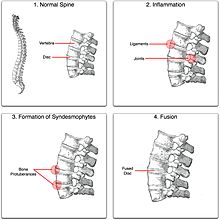Exercise as it relates to Disease/Ankylosing Spondylitis and Exercise
Ankylosing Spondylitis and Exercise
[edit | edit source]Background
[edit | edit source]Ankylosing spondylitis (AS) is an chronic, rheumatic disease part of a group of diseases known as spondyloarthropathier (SpA).[1] Ankylosing spondylitis is a result of inflammation in the spine affecting the synovial tissue, ligament insertions and invertebral discs[1] affecting the spine as well as the hips, knees and shoulders.[2] Inflammation of these areas causes trunk stiffness and pain. Additional calcification to these structures leads to mobility loss throughout the spine[1] and over time can progress to spinal deformity and loss of flexibility.[3]
Symptoms/Diagnosis
[edit | edit source]
Symptoms of ankylosing spondylitis can begin as early in the late teens, affecting males at a rate of 3:1 compared to females.[1] Males tend to have the spine affected to greater severity, where females have greater peripheral involvement.[4] AS is characterised by:
- Lower back or buttocks pain, radiating between sides [1]
- Persistent symptoms for >3months [4]
- Reduction of stiffness with exercises
- Stiffness in morning or with inactivity
Progression: As the inflammation continues new bone builds around the affected area causing increased fusing of the vertebrae[5]
Diagnosis is regarded as having the above symptoms. Other diagnostic tools that can be used include:[4]
- Radiology – to grade severity of AS
- Laboratory tests – it is thought that the HLA-B27 gene influences AS
Treatment/Management
[edit | edit source]There is no cure for ankylosing spondylitis, however treatment is designed to:[4]
- delay the progression of the disease
- relieve pain
- minimise inflammation
- maintain function
- improve quality of life
Methods of management of AS include:[1][4]
- education and counselling
- physiotherapy and chiropractic - to correct deformity and minimise spinal joint restriction [2][6]
- pharmaceutical - non-steroidal anti-inflammatory drugs (NSAIDs) or disease-modifying anti-rheumatoid drugs (DMARDs)
- exercise and stretching
Exercise and Stretching as management of ankylosing spondylitis
[edit | edit source]Exercise preserves mobility and prevents further deterioration in those with AS. Exercise programs should include a variety of the following types of exercises:[2][7]
| Exercise Type | Frequency | Benefits | Examples |
|---|---|---|---|
| Breathing Exercises | as appropriate |
|
diaphragmatic, abdominal and segmental breathing techniques |
| Mobility Exercises | daily |
|
exercises that use maximal ranges of motion. e.g. flexion, extension and rotation of the neck, spine and hips and free swinging of the major limbs |
| Flexibility Exercises | daily |
|
Stretches of the neck, shoulders, hips, knees and ankles |
| Strength Training | 1-3 times/week |
|
back extensors, shoulder retractors, hip extensors exercises performed on a gym ball |
| Cardiovascular Exercises (includes sport activities) | minimum 200min/week |
|
sports encouraging trunk rotation and extension while avoiding contact sports |
| Hydrotherapy | as directed by a professional |
|
breaststroke strokes aid in posture and breathing due to stoke motion opening up chest |
Home exercise programs should be designed to fit into daily routines and not all exercises need to be completed in one session.[7] It is recommended that you complete exercise when feels appropriate, e.g. if morning stiffness of hips occurs, stretch hips in the morning.
Recommendation
[edit | edit source]- Those with severe AS complications should have an exercise tolerance test conducted before starting a fitness program[7]
- Exercise at least 30 minutes per day [8]
- Complete back extension exercises minimum 5 days per week[7][8]
- Exercising in the water decreases the load on the body, so AS patients can exercise longer and more vigorously[7]
Recommended Readings
[edit | edit source]Exercises - world arthritis day
Exercises - Arthritis Research UK
Fact sheet - Arthritis Australia
Reference List
[edit | edit source]- ↑ a b c d e f Keat A. Ankylosing Spondylitis. Spondyloarthropathies. 2010;38(4):185-189
- ↑ a b c Ince G, Sarpel T, Durgun B, Erdogan S. Effects of a multimodal exercise program for people with ankylosing spondylitis. Phys Ther. 2006; 86:924-935.
- ↑ Viitanen J, Suni J. Management principles of physiotherapy in ankylosing spondylitis - which treatments are effective? Physiotherapy. 1995; 81(6):322-329
- ↑ a b c d e Calin A. Ankylosing spondylitis. Spondyloarthropathies. 2006; 34(10): 396-400
- ↑ Spondylitis Association of America (US). Ankylosing Spondylitis[Internet]. Sherman Oaks (CA): Spondylitis Association of America; 2013 [cited 2013 Oct 12]. Available from:http://www.spondylitis.org/about/as.aspx
- ↑ Rutherford SM, Nicolson CF, Crowther ER. Symptomatic improvement in function and disease activity in patient with ankylosing spondylitis utilizing a course of chiropractic therapy: a prospective case study.J Can Chiropr Assoc. 2005; 49(2):81-91
- ↑ a b c d e Nolte K, van Rensburg CJ. The role of exercise in the rehabilitation of ankylosing spondylitis. Int SportMed J. 2001;2(4):1-12
- ↑ a b Falkenbach A. Disability motivates patients with ankylosing spondylitis for more frequent physical exercise. Arch Phys Med Rehabil. 2003; 84:382-383